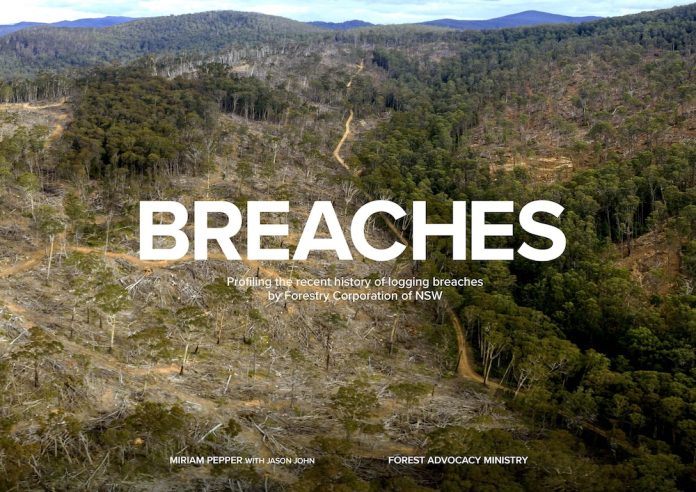As the people of NSW await the latest judgment of the Land and Environment Court for Forestry Corporation of NSW’s logging breaches, in this case illegally felling giant and hollow-bearing trees in Wild Cattle Creek State Forest near Coffs Harbour, a new book shines a light on the Corporation’s misdemeanours across the state.
The book, entitled Breaches, profiles illegal forestry operations since the Black Summer bushfires of 2019-2020 burned some 42 per cent of the state forests estate.
Breaches is published by the Forest Advocacy Ministry, a project of members of the Uniting Church and the Religious Society of Friends (Quakers), and is intended to be a community resource, especially at this time when the NSW government Independent Forestry Panel calls for submissions on the future of the forestry industry.
Eight forests on the south and north coasts are featured in the book: Mogo, South Brooman, Yambulla, Tallaganda, Styx River, Bagawa, Wild Cattle Creek and Doubleduke state forests. The book describes the nature of the breaches and how they came to light, the impacts on the affected forests, the outcomes of investigations by the NSW Environment Protection Authority (EPA), and crucial efforts by the community to hold Forestry Corporation to account. Failures to protect two endangered species – the southern greater glider and the koala – are also covered.
Book author and SSH Environment Editor, Dr Miriam Pepper, said, “Since 2020 the EPA has started and/or completed more than 50 formal investigations of Forestry Corp’s compliance, often after receiving complaints from the local community. More than 30 of these investigations have resulted in enforcement action so far, with fines and other costs totalling over $1.7 million.”
Some breaches have been prosecuted in the Land and Environment Court, with three cases completed since 2020 (for offences since 2018) and one pending, while another case was heard in a local court when Forestry Corporation unsuccessfully appealed a fine. These breaches include failing to abide by post-bushfire conditions that were intended to help surviving wildlife to recover, logging in prohibited areas, and felling hollow-bearing and giant trees.
Ms Pepper said, “Breaches can have serious consequences for wildlife. For example, cutting down trees with hollows used by hollow-dependent threatened species such as greater and yellow-bellied gliders, owls, parrots and glossy black-cockatoos destroys their homes.
“The Uniting Church believes God loves the divine creation and wills the development of its life. Each creature has its dignity and thereby also its right to existence and as the Season of Creation draws to a close, many of our churches are preparing to hold blessing of animals services.
“Yet, logging public native forests is placing numerous threatened species in NSW at further risk, and is undertaken by a government body that is a serial environmental offender and whose alleged breaching continues through to this year.”
Quaker Helen Gould from the Forest Advocacy Ministry, said, “Trees are like us: they breathe and drink; they eat and excrete, they re-create their kind, they grow and die. Like us they are subject to the rhythms of day and night, the pull of the moon’s tides, magnetism and gravity. I have come to know, sensuously, that community includes all beings. We must care for the forests and they will sustain us.”
Forest Chaplain and book coauthor the Rev. Dr Jason John, who lives and works within the proposed Great Koala National Park area on the state’s north coast, said, “The Forest Advocacy Ministry is proud to have drawn together the hard work of groups and individuals who love our forest neighbours. Breaches is a contribution to helping the government, and public of NSW, to answer the question, ‘Can Forestry Corporation be trusted with logging in forests with valuable wildlife habitat?’”
Copies of the book (electronic and hardcover) are available from www.breachesbook.org.





